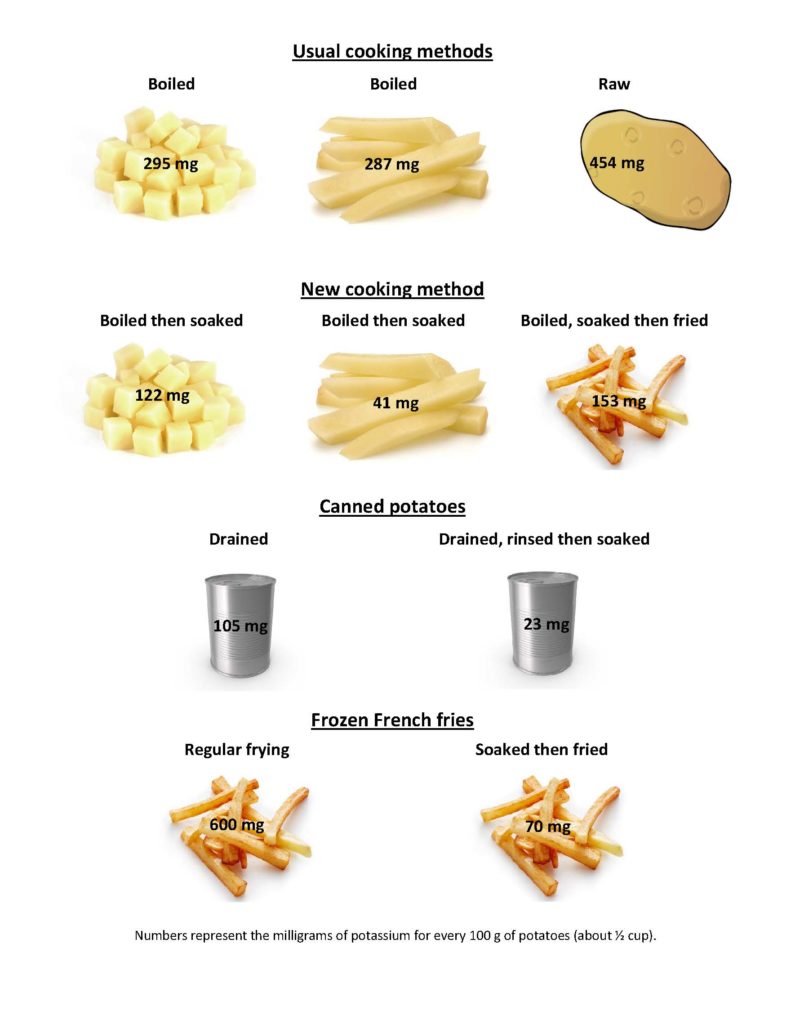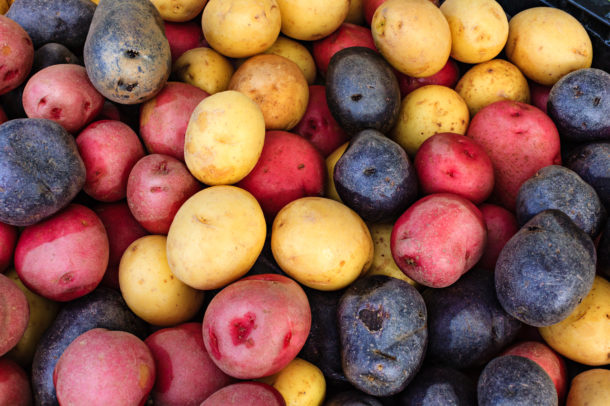Submitted by Fiona Bellefeuille, RD
For those of you on a low potassium diet you are likely aware of the high potassium content of potatoes. Over the years, experiments on how to make our potato lower in potassium have led to recommendation for double boiling the potatoes to leach some potassium. This method will remove about 50% of the potassium from your potato. Unfortunately, a potato with 50% less potassium is still considered a high potassium vegetable. A new study has taken the preparation of potatoes one step further and the good news is that this new method of preparing potatoes can produce a potato with much less potassium, allowing it to become part of a low potassium diet.
Here is what the study investigators found:
- Soaking fresh raw potatoes before cooking does not leach a significant amount of potassium from the potato, so basically, this method is a not worth the time.
- Not discouraged by this finding the investigators decided to see what happens when you soak a potato after cooking. They found that this method allows the potato to leach much more potassium. The size and shape of the cut potato also influenced how much potassium was leached out.
- Cutting potatoes into strips (1.2 cm x 1.2 cm) allowed the most potassium to leach out of the potatoes.
- Dice cutting (2 cm x 2 cm x 2 cm) still produced a fairly low potassium potato after cooking and soaking.
Other findings
- Canned potatoes are lower in potassium than fresh potatoes and when soaked in water they become even lower in potassium.
- Frozen French fries are high in potassium, however when soaked in water before frying they become much lower in potassium.
What about taste and texture?
This study also involved taste and texture testing of all products and found all methods produced similar taste and texture.
Here are the potassium leaching methods used
Fresh potatoes
- Peel the potatoes
- Cut into strips (1.2 cm x 1.2 cm) or dice (2 cm x 2 cm x 2 cm)
- Boil in water (1.5 L) for 8 minutes
- Drain potatoes
- Add clean water (1.5 litres) and soak for 12 hours
- Use as required, e.g. mash, potato salad, home fries, baked
Canned potatoes
- Wash and drain
- Soak in water (1.5 L) for 12 hours
- Use as required
Frozen french fries
- Soak frozen fries in water (1.5 L) for 12 hours
- Drain and dry fries
- Prepare in the usual way
The results
The table below identifies how much potassium is in 100 g (approximately ½ cup) of potatoes after preparation. The recommended daily potassium intake for someone following a low potassium diet is less than 2,000 mg.
| Type of potato (100 g) | Potassium (mg) |
| Raw | 454 |
| Strip cut, boiled | 287 |
| Dice cut, boiled | 295 |
| Strip cut, boiled for 8 minutes then soaked in water for 12 hours | 41 |
| Strip cut, boiled for 8 minutes then soaked in water for 12 hours then deep-fried* | 153 |
| Dice cut, boiled for 8 minutes then soaked in water for 12 hours | 122 |
| Canned | 105 – 118 |
| Canned soaked in water for 12 hours | 23 – 31 |
| Frozen fries, fried* | 600 – 700 |
| Frozen fries, soaked in water for 12 hours then fried* | 70 – 90 |

Once you have boiled and soaked your potatoes try to prepare them in a method with little added fat to keep the calorie content down. Remember potatoes are still high in carbohydrates so if you have diabetes they can increase your blood sugar if consumed in large quantities.
Now you can cook your potatoes, soak them and enjoy them too knowing that this preparation method can produce a much lower potassium potato.
Reference: Montserrat Martinez-Pineda, Cristina Yague-Ruiz, Antonio Vercet-Tormo: Is it possible to include potato in the diet of chronic kidney disease patients? New culinary alternatives for limiting potassium content; Journal of Renal Nutrition, Vol 30, No 3 (May), 2020 pp 251-260
